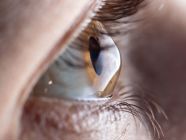Farsightedness (Hyperopia) is a condition where nearby objects appear blurry, while distant objects remain clear. For example, a child may struggle with close-up tasks like reading, seeing words as blurry or unclear, while distant objects appear sharp.
What Causes Farsightedness in Children?
Farsightedness occurs when light entering the eye focuses behind the retina instead of directly on it. This usually happens because the internal eye muscles lack proper focusing ability, or because the eyeball is shorter than normal.
Children may inherit farsightedness from their parents. If one parent has hyperopia, the child is more likely to develop it too. However, children can still develop farsightedness even if neither parent has it, as many other factors may lead to this condition (2).
Is Farsightedness Normal in Childhood?
Farsightedness is common and normal during early childhood. Most children are born with a mild degree of hyperopia, especially in the first 7–8 years of life. During this phase, their vision remains clear at both near and far distances because their eyes can adapt and focus effectively. As the child grows and the eye elongates, hyperopia usually reduces and disappears by adolescence (3).
However, when farsightedness is severe, the eye muscles may not be able to focus properly, and the child may need prescription glasses to avoid complications like strabismus (crossed eyes) (2).
What Are the Symptoms of Farsightedness in Children?
Children with mild hyperopia:
Typically show no symptoms, as their flexible eye lenses can compensate across different distances (2).
Children with moderate to high hyperopia may show signs like (4):
In younger children:
- Squinting to focus on nearby objects
- Frequent blinking while looking at close things
- Rubbing their eyes due to strain
- Inward eye turning (strabismus)
In older children:
- Complaints of blurry near vision while distant vision remains clear
- Eye fatigue, especially when reading or using devices
- Headaches or tiredness after long periods of focus
- Struggles with schoolwork or reading
- Visible eye misalignment in some cases
What Happens if Farsightedness Isn’t Treated?
Unlike adults, untreated farsightedness in children may lead to complications like:
- Amblyopia (lazy eye)
- Strabismus
- Learning and focus issues in school, lowering academic performance
- Early diagnosis and treatment are key to preventing these issues.
Can Farsightedness Be Prevented in Children?
While farsightedness cannot always be prevented, early detection through routine eye exams helps ensure timely correction and prevents complications (4).
Eye exams are recommended at:
- Age 3–4 years
- Before school or within the first school year
How Is Farsightedness Treated in Children?
For children with moderate or severe hyperopia, or those with noticeable symptoms, corrective glasses or contact lenses (for older kids and teens) are typically prescribed (2).
Children with mild hyperopia and no vision problems often don’t need treatment, as the condition usually improves naturally over time (2).
Still, all children diagnosed with farsightedness should be evaluated by an eye specialist, as untreated cases can worsen or lead to issues like amblyopia (lazy eye).
Protect your child’s vision with expert care at the Pediatric Eye Clinic at Al-Ahli Hospital.
Book an eye screening today for early detection and comprehensive care.
References
- iScreen Vision - Pediatric Hyperopia FAQs
- American Academy of Ophthalmology - Farsightedness: What Is Hyperopia?
- American Association for Pediatric Ophthalmology and Strabismus - Refractive Errors in Children
- Raising Children Network - Long-sightedness






